Analysis of Droughts and Floods Evolution and Teleconnection Factors in the Yangtze River Basin Based on GRACE/GFO
Abstract
1. Introduction
2. Study Area and Data
2.1. Study Area
2.2. Data
2.2.1. GRACE/GFO Data
2.2.2. Hydrological Model
2.2.3. SPEI
2.2.4. The Self-Calibrating Palmer Drought Severity Index (scPDSI)
2.2.5. Teleconnection Factors
3. Methods
3.1. Water Storage Deficit Index (WSDI)
3.2. The Modified Mann–Kendall (MMK) Trend Test
3.3. Theil–Sen Slope
3.4. Singular Spectral Analysis (SSA)
3.5. Cross Wavelet Transform (XWT) and Wavelet Transform Coherence (WTC)
4. Results
4.1. Reliability Verification
4.1.1. GRACE/GFO Assessment
4.1.2. WSDI Assessment
4.2. Drought and Flood Events Based on WSDI
4.2.1. Identification of Drought and Flood Events
4.2.2. Typical Drought and Flood Events
4.3. Spatial and Temporal Evolution of WSDI
4.4. Dynamic Response of WSDI and Teleconnection Factors
5. Discussion
5.1. Advantages of WSDI for Recognizing Drought and Flood Events
5.2. Analysis of Influencing Factors of Droughts and Floods
5.3. Limitations and Prospects
6. Conclusions
Author Contributions
Funding
Data Availability Statement
Conflicts of Interest
References
- Frich, P.; Alexander, L.V.; Della-Marta, P.; Gleason, B.; Haylock, M.; Tank, A.M.G.K.; Peterson, T. Observed coherent changes in climatic extremes during the second half of the twentieth century. Clim. Res. 2002, 19, 193–212. [Google Scholar] [CrossRef]
- Barredo, J.I. Major flood disasters in Europe: 1950–2005. Nat. Hazards 2007, 42, 125–148. [Google Scholar] [CrossRef]
- Mishra, A.K.; Singh, V.P. A review of drought concepts. J. Hydrol. 2010, 391, 202–216. [Google Scholar] [CrossRef]
- Van Loon, A.F. Hydrological drought explained. WIREs Water 2015, 2, 359–392. [Google Scholar] [CrossRef]
- Wu, J.; Chen, X.; Lu, J. Assessment of long and short-term flood risk using the multi-criteria analysis model with the AHP-Entropy method in Poyang Lake basin. Int. J. Disaster Risk Reduct. 2022, 75, 102968. [Google Scholar] [CrossRef]
- Tellman, B.; Sullivan, J.A.; Kuhn, C.; Kettner, A.J.; Doyle, C.S.; Brakenridge, G.R.; Erickson, T.A.; Slayback, D.A. Satellite imaging reveals increased proportion of population exposed to floods. Nature 2021, 596, 80–86. [Google Scholar] [CrossRef]
- Wang, H.; Wang, S.; Shu, X.; He, Y.; Huang, J. Increasing Occurrence of Sudden Turns From Drought to Flood Over China. J. Geophys. Res. Atmos. 2024, 129, e2023JD039974. [Google Scholar] [CrossRef]
- Rodell, M.; Li, B. Changing intensity of hydroclimatic extreme events revealed by GRACE and GRACE-FO. Nat. Water 2023, 1, 241–248. [Google Scholar] [CrossRef]
- Jin, W.; Qi-hua, R.A.N.; Lin, L.I.U.; Hai-long, P.A.N.; Sheng, Y.E. Research on the Dominant Mechanism of Extreme Flow Events in the Middle and Lower Reaches of the Yangtze River. China Rural Water Hydropower 2022, 6, 119–124. [Google Scholar]
- Yang, P.; Xia, J.; Luo, X.; Meng, L.; Zhang, S.; Cai, W.; Wang, W. Impacts of climate change-related flood events in the Yangtze River Basin based on multi-source data. Atmos. Res. 2021, 263, 105819. [Google Scholar] [CrossRef]
- McKee, T.B.; Doesken, N.J.; Kleist, J. The relationship of drought frequency and duration to time scales. In Proceedings of the 8th Conference on Applied Climatology, Anaheim, CA, USA, 17–22 January 1993; pp. 179–183. [Google Scholar]
- Shukla, S.; Wood, A.W. Use of a standardized runoff index for characterizing hydrologic drought. Geophys. Res. Lett. 2008, 35, L02405. [Google Scholar] [CrossRef]
- Beguería, S.; Vicente-Serrano, S.M.; Angulo-Martínez, M. A Multiscalar Global Drought Dataset: The SPEIbase: A New Gridded Product for the Analysis of Drought Variability and Impacts. Bull. Am. Meteorol. Soc. 2010, 91, 1351–1356. [Google Scholar] [CrossRef]
- Nigatu, Z.M.; Fan, D.; You, W.; Melesse, A.M. Hydroclimatic Extremes Evaluation Using GRACE/GRACE-FO and Multidecadal Climatic Variables over the Nile River Basin. Remote Sens. 2021, 13, 651. [Google Scholar] [CrossRef]
- Wang, J.; Chen, Y.; Wang, Z.; Shang, P. Drought evaluation over Yangtze River basin based on weighted water storage deficit. J. Hydrol. 2020, 591, 125283. [Google Scholar] [CrossRef]
- Cai, J.; Zhang, Y.; Li, Y.; Liang, X.; Jiang, T. Analyzing the Characteristics of Soil Moisture Using GLDAS Data: A Case Study in Eastern China. Appl. Sci. 2017, 7, 566. [Google Scholar] [CrossRef]
- Yi, H.; Wen, L. Satellite gravity measurement monitoring terrestrial water storage change and drought in the continental United States. Sci. Rep. 2016, 6, 19909. [Google Scholar] [CrossRef]
- Huang, S.; Zhang, H.; Liu, Y.; Liu, W.; Wei, F.; Yang, C.; Ding, F.; Ye, J.; Nie, H.; Du, Y.; et al. Assessment of Hydrological and Meteorological Composite Drought Characteristics Based on Baseflow and Precipitation. Water 2024, 16, 1466. [Google Scholar] [CrossRef]
- Li, Z.; Shen, H.; Weng, Q.; Zhang, Y.; Dou, P.; Zhang, L. Cloud and cloud shadow detection for optical satellite imagery: Features, algorithms, validation, and prospects. ISPRS J. Photogramm. Remote Sens. 2022, 188, 89–108. [Google Scholar] [CrossRef]
- Ramillien, G.; Famiglietti, J.S.; Wahr, J. Detection of Continental Hydrology and Glaciology Signals from GRACE: A Review. Surv. Geophys. 2008, 29, 361–374. [Google Scholar] [CrossRef]
- Zhang, L.; Shen, Y.; Chen, Q.; Wang, F. Influence factors and mechanisms of 2015–2016 extreme flood in Pearl River Basin based on the WSDI from GRACE. J. Hydrol. Reg. Stud. 2023, 47, 101376. [Google Scholar] [CrossRef]
- Liu, S.; Wu, Y.; Xu, G.; Xiao, C.; Wu, X.; Zhong, Y. Revealing the spatiotemporal evolution of the 2024 extreme flood in Guangdong Province: Insights from GRACE-FO and in situ measurements. J. Hydrol. Reg. Stud. 2025, 59, 102451. [Google Scholar] [CrossRef]
- Cui, L.; Yu, L.; Bo, Z.; Jiachuan, A.; Jiacheng, M.; Haoyang, G.; Xu, C. Assessing the impact of 2022 extreme drought on the Yangtze River basin using downscaled GRACE/GRACE-FO data obtained by partitioned random forest algorithm. Int. J. Remote Sens. 2025, 46, 1219–1247. [Google Scholar] [CrossRef]
- Uz, M.; Akyilmaz, O.; Shum, C.K. Deep learning-aided temporal downscaling of GRACE-derived terrestrial water storage anomalies across the Contiguous United States. J. Hydrol. 2024, 645, 132194. [Google Scholar] [CrossRef]
- Xiao, C.; Zhong, Y.; Wu, Y.; Bai, H.; Li, W.; Wu, D.; Wang, C.; Tian, B. Applying Reconstructed Daily Water Storage and Modified Wetness Index to Flood Monitoring: A Case Study in the Yangtze River Basin. Remote Sens. 2023, 15, 3192. [Google Scholar] [CrossRef]
- Yin, J.; Wei, J.; Li, Q.; Ayantobo, O.O. Regional Characteristics and Impact Factors of Change in Terrestrial Water Storage in Northwestern China From 2002 to 2020. IEEE J. Sel. Top. Appl. Earth Obs. Remote Sens. 2023, 16, 386–398. [Google Scholar] [CrossRef]
- Ren, J.; Xu, M.; Kang, S.; Han, H.; Li, X.; Hou, Z. Comprehensive understanding of hydrological drought based on GRACE data at multiple spatiotemporal scales in Northwest China. Nat. Hazards 2025, 121, 2465–2481. [Google Scholar] [CrossRef]
- Luo, X.; Wu, T.; Lu, L.; Chao, N.; Liu, Z.; Peng, Y. Using Geodetic Data to Monitor Hydrological Drought at Different Spatial Scales: A Case Study of Brazil and the Amazon Basin. Remote Sens. 2025, 17, 1670. [Google Scholar] [CrossRef]
- Yang, S.; Zhong, Y.; Wu, Y.; Yang, K.; An, Q.; Bai, H.; Liu, S. Quantifying long-term drought in China’s exorheic basins using a novel daily GRACE reconstructed TWSA index. J. Hydrol. 2025, 655, 132919. [Google Scholar] [CrossRef]
- Terwayet Bayouli, O.; Zhang, W.; Terwayet Bayouli, H.; Zhang, Z.; Ma, Q. Grace-based assessment of hydrometeorological droughts and their Possible teleconnection Mechanisms using wavelet based quantitative approach. Int. J. Appl. Earth Obs. Geoinf. 2025, 137, 104410. [Google Scholar] [CrossRef]
- Zheng, W.; Askari, K.; Song, C.; Shi, P.; Ge, W.; Shi, S.; Chu, J.; Chen, H.; Wang, F. Increasing vulnerability of vegetation to Meteorological and Groundwater drought: A Case study in Argentina. J. Hydrol. Reg. Stud. 2024, 55, 101931. [Google Scholar] [CrossRef]
- Wu, S.; Dong, Z.; Cai, C.; Zhu, S.; Shao, Y.; Meng, J.; Amponsah, G.E. Identification of Extreme Droughts Based on a Coupled Hydrometeorology Index from GRACE-Derived TWSA and Precipitation in the Yellow River and Yangtze River Basins. Water 2023, 15, 1990. [Google Scholar] [CrossRef]
- Liu, J.; Zhu, G.; Zhao, K.; Jiao, Y.; Liu, Y.; Yang, M.; Zhang, W.; Qiu, D.; Lin, X.; Ye, L. GRACE Combined with WSD to Assess the Change in Drought Severity in Arid Asia. Remote Sens. 2022, 14, 3454. [Google Scholar] [CrossRef]
- Topçu, E. Drought Characterization Using the Grace Terrestrial Water Storage Deficit in Turkey. J. Indian Soc. Remote Sens. 2024, 52, 1003–1018. [Google Scholar] [CrossRef]
- Getahun, Y.S.; Li, M.-H.; Chen, Y.-Y.; Yate, T.A. Drought characterization and severity analysis using GRACE-TWS and MODIS datasets: A case study from the Awash River Basin (ARB), Ethiopia. J. Water Clim. Chang. 2023, 14, 516–542. [Google Scholar] [CrossRef]
- Ali, S.; Khorrami, B.; Jehanzaib, M.; Tariq, A.; Ajmal, M.; Arshad, A.; Shafeeque, M.; Dilawar, A.; Basit, I.; Zhang, L.; et al. Spatial Downscaling of GRACE Data Based on XGBoost Model for Improved Understanding of Hydrological Droughts in the Indus Basin Irrigation System (IBIS). Remote Sens. 2023, 15, 873. [Google Scholar] [CrossRef]
- Xu, G.; Wu, Y.; Liu, S.; Cheng, S.; Zhang, Y.; Pan, Y.; Wang, L.; Dokuchits, E.Y.; Nkwazema, O.C. How 2022 extreme drought influences the spatiotemporal variations of terrestrial water storage in the Yangtze River Catchment: Insights from GRACE-based drought severity index and in-situ measurements. J. Hydrol. 2023, 626, 130245. [Google Scholar] [CrossRef]
- Zhong, Y.; Hu, E.; Wu, Y.; An, Q.; Wang, C.; Bai, H.; Gao, W. Reconstructing a long-term water storage-based drought index in the Yangtze River Basin. Sci. Total Environ. 2023, 883, 163403. [Google Scholar] [CrossRef]
- Hao, H.; Yang, M.; Wang, H.; Dong, N. Human activities reshape the drought regime in the Yangtze River Basin: A land surface-hydrological modelling analysis with representations of dam operation and human water use. Nat. Hazards 2023, 118, 2097–2121. [Google Scholar] [CrossRef]
- Feng, K.; Cao, Y.; Du, E.; Zhou, Z.; Zhang, Y. Spatiotemporal Dynamics of Drought and the Ecohydrological Response in Central Asia. Remote Sens. 2025, 17, 166. [Google Scholar] [CrossRef]
- Liu, X.; Feng, X.; Ciais, P.; Fu, B.; Hu, B.; Sun, Z. GRACE satellite-based drought index indicating increased impact of drought over major basins in China during 2002–2017. Agric. For. Meteorol. 2020, 291, 108057. [Google Scholar] [CrossRef]
- Wang, L.; Peng, Z.; Ma, X.; Zheng, Y.; Chen, C. Multiscale gravity measurements to characterize 2020 flood events and their spatio-temporal evolution in Yangtze river of China. J. Hydrol. 2021, 603, 127176. [Google Scholar] [CrossRef]
- Cui, A.; Li, J.; Zhou, Q.; Zhu, R.; Liu, H.; Wu, G.; Li, Q. Use of a multiscalar GRACE-based standardized terrestrial water storage index for assessing global hydrological droughts. J. Hydrol. 2021, 603, 126871. [Google Scholar] [CrossRef]
- Sun, A.Y.; Scanlon, B.R.; AghaKouchak, A.; Zhang, Z. Using GRACE Satellite Gravimetry for Assessing Large-Scale Hydrologic Extremes. Remote Sens. 2017, 9, 1287. [Google Scholar] [CrossRef]
- Wang, F.; Wang, Z.; Yang, H.; Di, D.; Zhao, Y.; Liang, Q. Utilizing GRACE-based groundwater drought index for drought characterization and teleconnection factors analysis in the North China Plain. J. Hydrol. 2020, 585, 124849. [Google Scholar] [CrossRef]
- Ma, W.; Zhou, H.; Dai, M.; Tang, L.; Xu, S.; Luo, Z. Characterizing the drought events in Yangtze River basin via the insight view of its sub-basins water storage variations. J. Hydrol. 2024, 633, 130995. [Google Scholar] [CrossRef]
- Ni, S.; Chen, J.; Wilson, C.R.; Li, J.; Hu, X.; Fu, R. Global Terrestrial Water Storage Changes and Connections to ENSO Events. Surv. Geophys. 2018, 39, 1–22. [Google Scholar] [CrossRef]
- Liu, X.; Feng, X.; Ciais, P.; Fu, B. Widespread decline in terrestrial water storage and its link to teleconnections across Asia and eastern Europe. Hydrol. Earth Syst. Sci. 2020, 24, 3663–3676. [Google Scholar] [CrossRef]
- Neves, M.C. Links Between Extremes in GRACE TWS and Climate Patterns Across Iberia. Water 2025, 17, 1108. [Google Scholar] [CrossRef]
- Scanlon, B.R.; Rateb, A.; Anyamba, A.; Kebede, S.; MacDonald, A.M.; Shamsudduha, M.; Small, J.; Sun, A.; Taylor, R.G.; Xie, H. Linkages between GRACE water storage, hydrologic extremes, and climate teleconnections in major African aquifers. Environ. Res. Lett. 2022, 17, 014046. [Google Scholar] [CrossRef]
- Zhi, R.; Wang, Q.; Feng, G.; Feng, A. Using moving North Pacific index to improve rainy season rainfall forecast over the Yangtze River basin by analog error correction. J. Meteorol. Res. 2015, 29, 627–638. [Google Scholar] [CrossRef]
- Wang, F.; Lai, H.; Li, Y.; Feng, K.; Tian, Q.; Guo, W.; Qu, Y.; Yang, H. Spatio-temporal evolution and teleconnection factor analysis of groundwater drought based on the GRACE mascon model in the Yellow River Basin. J. Hydrol. 2023, 626, 130349. [Google Scholar] [CrossRef]
- Li, R.; Jin, W. The role of the Yangtze River Protection Law in the emergence of adaptive water governance in China. Ecol. Soc. 2023, 28, 32. [Google Scholar] [CrossRef]
- Chao, N.; Wang, Z. Characterized Flood Potential in the Yangtze River Basin from GRACE Gravity Observation, Hydrological Model, and In-Situ Hydrological Station. J. Hydrol. Eng. 2017, 22, 05017016. [Google Scholar] [CrossRef]
- Li, B.; Chen, N.; Wang, W.; Wang, C.; Schmitt, R.J.P.; Lin, A.; Daily, G.C. Eco-environmental impacts of dams in the Yangtze River Basin, China. Sci. Total Environ. 2021, 774, 145743. [Google Scholar] [CrossRef] [PubMed]
- Zhang, X.; Hao, Z.; Singh, V.P.; Zhang, Y.; Feng, S.; Xu, Y.; Hao, F. Drought propagation under global warming: Characteristics, approaches, processes, and controlling factors. Sci. Total Environ. 2022, 838, 156021. [Google Scholar] [CrossRef]
- Zhang, L.; Sun, W. Progress and prospect of GRACE Mascon product and its application. Rev. Geophys. Planet. Phys. 2022, 53, 35–52. [Google Scholar] [CrossRef]
- Zhang, L.; Yi, S.; Wang, Q.; Chang, L.; Tang, H.; Sun, W. Evaluation of GRACE mascon solutions for small spatial scales and localized mass sources. Geophys. J. Int. 2019, 218, 1307–1321. [Google Scholar] [CrossRef]
- Zhong, Y.; Feng, W.; Humphrey, V.; Zhong, M. Human-Induced and Climate-Driven Contributions to Water Storage Variations in the Haihe River Basin, China. Remote Sens. 2019, 11, 3050. [Google Scholar] [CrossRef]
- Rodell, M.; Houser, P.R.; Jambor, U.; Gottschalck, J.; Mitchell, K.; Meng, C.-J.; Arsenault, K.; Cosgrove, B.; Radakovich, J.; Bosilovich, M.; et al. The Global Land Data Assimilation System. Bull. Am. Meteorol. Soc. 2004, 85, 381–394. [Google Scholar] [CrossRef]
- Müller Schmied, H.; Cáceres, D.; Eisner, S.; Flörke, M.; Herbert, C.; Niemann, C.; Peiris, T.A.; Popat, E.; Portmann, F.T.; Reinecke, R.; et al. The global water resources and use model WaterGAP v2.2d: Model description and evaluation. Geosci. Model Dev. 2021, 14, 1037–1079. [Google Scholar] [CrossRef]
- Vicente-Serrano, S.M.; Beguería, S.; López-Moreno, J.I. A Multiscalar Drought Index Sensitive to Global Warming: The Standardized Precipitation Evapotranspiration Index. J. Clim. 2010, 23, 1696–1718. [Google Scholar] [CrossRef]
- Wells, N.; Goddard, S.; Hayes, M.J. A Self-Calibrating Palmer Drought Severity Index. J. Clim. 2004, 17, 2335–2351. [Google Scholar] [CrossRef]
- Park, C.-H.; Son, S.-W. Subseasonal Variability of ENSO–East Asia Teleconnections Driven by Tropical Convection Over the Indian Ocean and Maritime Continent. Geophys. Res. Lett. 2024, 51, e2023GL108062. [Google Scholar] [CrossRef]
- Simpkins, G. Breaking down the NAO–AO connection. Nat. Rev. Earth Environ. 2021, 2, 88. [Google Scholar] [CrossRef]
- Thomas, E.; Abraham, N.P. Relationship between sunspot number and seasonal rainfall over Kerala using wavelet analysis. J. Atmos. Sol.-Terr. Phys. 2022, 240, 105943. [Google Scholar] [CrossRef]
- Thomas, A.C.; Reager, J.T.; Famiglietti, J.S.; Rodell, M. A GRACE-based water storage deficit approach for hydrological drought characterization. Geophys. Res. Lett. 2014, 41, 1537–1545. [Google Scholar] [CrossRef]
- Sinha, D.; Syed, T.H.; Famiglietti, J.S.; Reager, J.T.; Thomas, R.C. Characterizing Drought in India Using GRACE Observations of Terrestrial Water Storage Deficit. J. Hydrometeorol. 2017, 18, 381–396. [Google Scholar] [CrossRef]
- Nie, N.; Zhang, W.; Chen, H.; Guo, H. A Global Hydrological Drought Index Dataset Based on Gravity Recovery and Climate Experiment (GRACE) Data. Water Resour. Manag. 2018, 32, 1275–1290. [Google Scholar] [CrossRef]
- Zou, R.; Yin, Y.; Wang, X.; Zhang, Z.; Ma, X.; Liu, M.; Ullah, I. Characteristics and propagation of meteorological and hydrological droughts in eastern Gansu, a typical semi-arid region, China. Int. J. Climatol. 2023, 43, 5327–5347. [Google Scholar] [CrossRef]
- Guo, Y.; Huang, S.; Huang, Q.; Wang, H.; Fang, W.; Yang, Y.; Wang, L. Assessing socioeconomic drought based on an improved Multivariate Standardized Reliability and Resilience Index. J. Hydrol. 2019, 568, 904–918. [Google Scholar] [CrossRef]
- Walwer, D.; Calais, E.; Ghil, M. Data-adaptive detection of transient deformation in geodetic networks. J. Geophys. Res. Solid Earth 2016, 121, 2129–2152. [Google Scholar] [CrossRef]
- Torrence, C.; Compo, G.P. A Practical Guide to Wavelet Analysis. Bull. Am. Meteorol. Soc. 1998, 79, 61–78. [Google Scholar] [CrossRef]
- Huang, S.; Huang, Q.; Chang, J.; Zhu, Y.; Leng, G.; Xing, L. Drought structure based on a nonparametric multivariate standardized drought index across the Yellow River basin, China. J. Hydrol. 2015, 530, 127–136. [Google Scholar] [CrossRef]
- Xue, H.; Zhang, R.; Luan, W.; Yuan, Z. The Spatiotemporal Variations in and Propagation of Meteorological, Agricultural, and Groundwater Droughts in Henan Province, China. Agriculture 2024, 14, 1840. [Google Scholar] [CrossRef]
- Veleda, D.; Montagne, R.; Araujo, M. Cross-Wavelet Bias Corrected by Normalizing Scales. J. Atmos. Ocean. Technol. 2012, 29, 1401–1408. [Google Scholar] [CrossRef]
- Cohen, M.X. A better way to define and describe Morlet wavelets for time-frequency analysis. NeuroImage 2019, 199, 81–86. [Google Scholar] [CrossRef]
- Cao, Y.; Nan, Z.; Cheng, G. GRACE Gravity Satellite Observations of Terrestrial Water Storage Changes for Drought Characterization in the Arid Land of Northwestern China. Remote Sens. 2015, 7, 1021–1047. [Google Scholar] [CrossRef]
- Deng, H.; Li, Y.; Zhang, Y.; Chen, X. Monitoring spatio-temporal variations of terrestrial water storage changes and their potential influencing factors in a humid subtropical climate region of Southeast China. J. Hydrol. 2024, 634, 131095. [Google Scholar] [CrossRef]
- Deng, H.; Chen, Y.; Chen, X. Driving factors and changes in components of terrestrial water storage in the endorheic Tibetan Plateau. J. Hydrol. 2022, 612, 128225. [Google Scholar] [CrossRef]
- Hsu, Y.-J.; Fu, Y.; Bürgmann, R.; Hsu, S.-Y.; Lin, C.-C.; Tang, C.-H.; Wu, Y.-M. Assessing seasonal and interannual water storage variations in Taiwan using geodetic and hydrological data. Earth Planet. Sci. Lett. 2020, 550, 116532. [Google Scholar] [CrossRef]
- Li, B.; Rodell, M.; Kumar, S.; Beaudoing, H.K.; Getirana, A.; Zaitchik, B.F.; de Goncalves, L.G.; Cossetin, C.; Bhanja, S.; Mukherjee, A.; et al. Global GRACE Data Assimilation for Groundwater and Drought Monitoring: Advances and Challenges. Water Resour. Res. 2019, 55, 7564–7586. [Google Scholar] [CrossRef]
- Ran, Y.; Zhong, M.; Chen, W.; Zhong, Y.; Feng, W. Monitoring the extreme drought in the middle and lower reaches of the Yangtze River in 2019 from GRACE-FO satellites. Chin. Sci. Bull. 2020, 66, 107–117. [Google Scholar] [CrossRef]
- Wu, X.; Wang, L.; Niu, Z.; Jiang, W.; Cao, Q. More extreme precipitation over the Yangtze River Basin, China: Insights from historical and projected perspectives. Atmos. Res. 2023, 292, 106883. [Google Scholar] [CrossRef]
- Zhong, Y.; Bai, H.; Feng, W.; Lu, J.; Humphrey, V. Separating the Precipitation- and Non-Precipitation- Driven Water Storage Trends in China. Water Resour. Res. 2023, 59, e2022WR033261. [Google Scholar] [CrossRef]
- Pokhrel, Y.; Felfelani, F.; Satoh, Y.; Boulange, J.; Burek, P.; Gädeke, A.; Gerten, D.; Gosling, S.N.; Grillakis, M.; Gudmundsson, L.; et al. Global terrestrial water storage and drought severity under climate change. Nat. Clim. Chang. 2021, 11, 226–233. [Google Scholar] [CrossRef]
- Nott, A.H.; Allen, D.M.; Hahm, W.J. Groundwater Responses to Deluge and Drought in the Fraser Valley, Pacific Northwest. Water Resour. Res. 2024, 60, e2023WR036769. [Google Scholar] [CrossRef]
- Jehanzaib, M.; Sattar, M.N.; Lee, J.-H.; Kim, T.-W. Investigating effect of climate change on drought propagation from meteorological to hydrological drought using multi-model ensemble projections. Stoch. Environ. Res. Risk Assess. 2020, 34, 7–21. [Google Scholar] [CrossRef]
- Zhou, Z.-Q.; Xie, S.-P.; Zhang, R. Historic Yangtze flooding of 2020 tied to extreme Indian Ocean conditions. Proc. Natl. Acad. Sci. 2021, 118, e2022255118. [Google Scholar] [CrossRef]
- Li, C.; Lu, R.; Dunstone, N.; Scaife, A.A.; Bett, P.E.; Zheng, F. The Seasonal Prediction of the Exceptional Yangtze River Rainfall in Summer 2020. Adv. Atmos. Sci. 2021, 38, 2055–2066. [Google Scholar] [CrossRef]
- Lyu, Z.-Z.; Gao, H.; Gao, R.; Ding, T. Extreme characteristics and causes of the drought event in the whole Yangtze River Basin in the midsummer of 2022. Adv. Clim. Chang. Res. 2023, 14, 642–650. [Google Scholar] [CrossRef]
- Dash, M.K.; Pandey, P.C.; Vyas, N.K.; Turner, J. Variability in the ENSO-induced southern hemispheric circulation and Antarctic sea ice extent. Int. J. Climatol. 2013, 33, 778–783. [Google Scholar] [CrossRef]
- Wang, J.; Liang, Z.; Wang, D.; Liu, T.; Yang, J. Impact of Climate Change on Hydrologic Extremes in the Upper Basin of the Yellow River Basin of China. Adv. Meteorol. 2016, 2016, 1404290. [Google Scholar] [CrossRef]
- Chowdhury, M.R. The El Niño-Southern Oscillation (ENSO) and seasonal flooding–Bangladesh. Theor. Appl. Climatol. 2003, 76, 105–124. [Google Scholar] [CrossRef]
- Power, S.; Delage, F.; Chung, C.; Kociuba, G.; Keay, K. Robust twenty-first-century projections of El Niño and related precipitation variability. Nature 2013, 502, 541–545. [Google Scholar] [CrossRef] [PubMed]
- Song, C.; Fan, C.; Zhu, J.; Wang, J.; Sheng, Y.; Liu, K.; Chen, T.; Zhan, P.; Luo, S.; Yuan, C.; et al. A comprehensive geospatial database of nearly 100 000 reservoirs in China. Earth Syst. Sci. Data 2022, 14, 4017–4034. [Google Scholar] [CrossRef]
- Lai, Y.; Zhang, B.; Yao, Y.; Li, J. Quantitatively Analyzing the Impacts of Seasonal Water Storage Changes in the Three Gorges Reservoir on Nearby Crust. Pure Appl. Geophys. 2022, 179, 817–831. [Google Scholar] [CrossRef]
- Wang, Y.; Long, D.; Li, X. High-temporal-resolution monitoring of reservoir water storage of the Lancang-Mekong River. Remote Sens. Environ. 2023, 292, 113575. [Google Scholar] [CrossRef]
- Cheng, H.; Wang, T.; Yang, D. Quantifying the Regulation Capacity of the Three Gorges Reservoir on Extreme Hydrological Events and Its Impact on Flow Regime in a Changing Climate. Water Resour. Res. 2024, 60, e2023WR036329. [Google Scholar] [CrossRef]
- Huang, Z.; Jiao, J.J.; Luo, X.; Pan, Y.; Jin, T. Drought and Flood Characterization and Connection to Climate Variability in the Pearl River Basin in Southern China Using Long-Term GRACE and Reanalysis Data. J. Clim. 2021, 34, 2053–2078. [Google Scholar] [CrossRef]
- Feng, T.; Shen, Y.; Chen, Q.; Wang, F.; Zhang, X. Groundwater storage change and driving factor analysis in north china using independent component decomposition. J. Hydrol. 2022, 609, 127708. [Google Scholar] [CrossRef]
- Chen, Z.W.; Zhang, X.F.; Zhou, B.Y.; Cui, J.W. Filling method and accuracy analysis of missing values of monthly GRACE temporal gravity model. Prog. Geophys. 2020, 35, 815–822. [Google Scholar] [CrossRef]
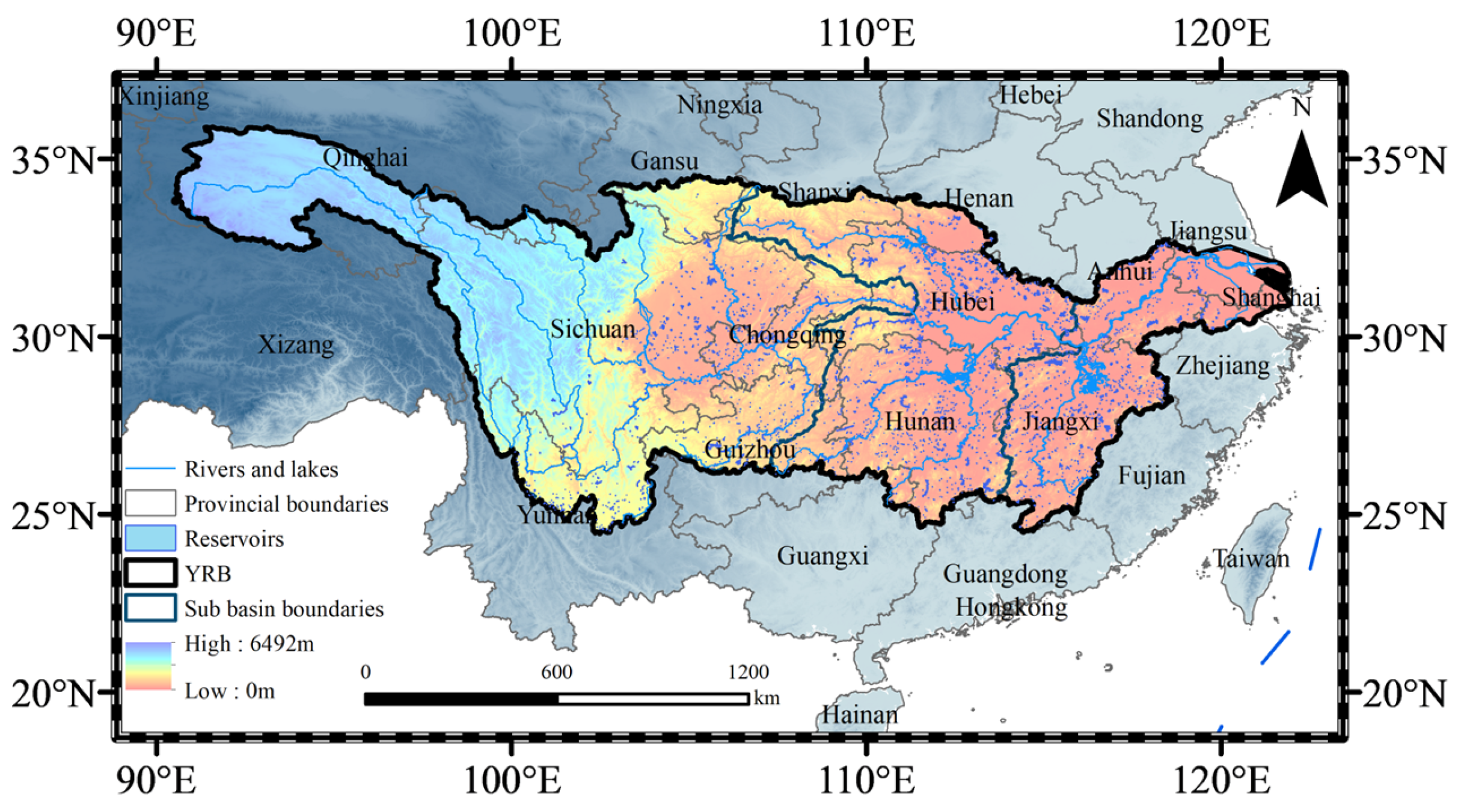



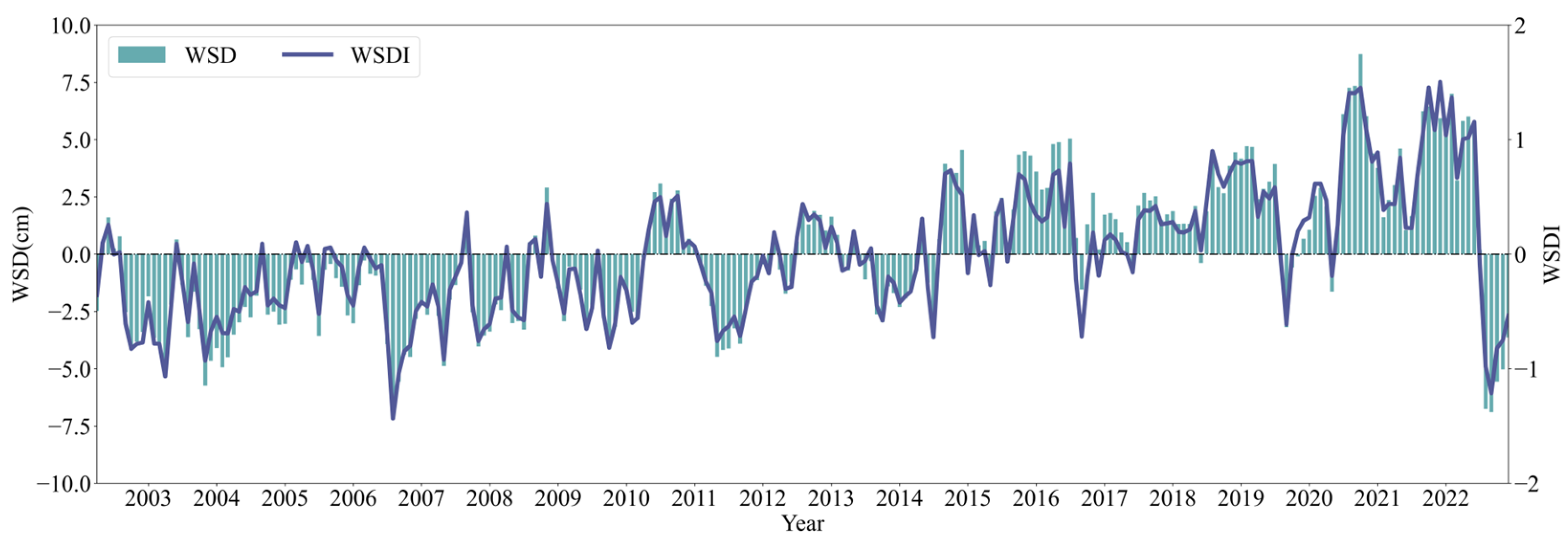
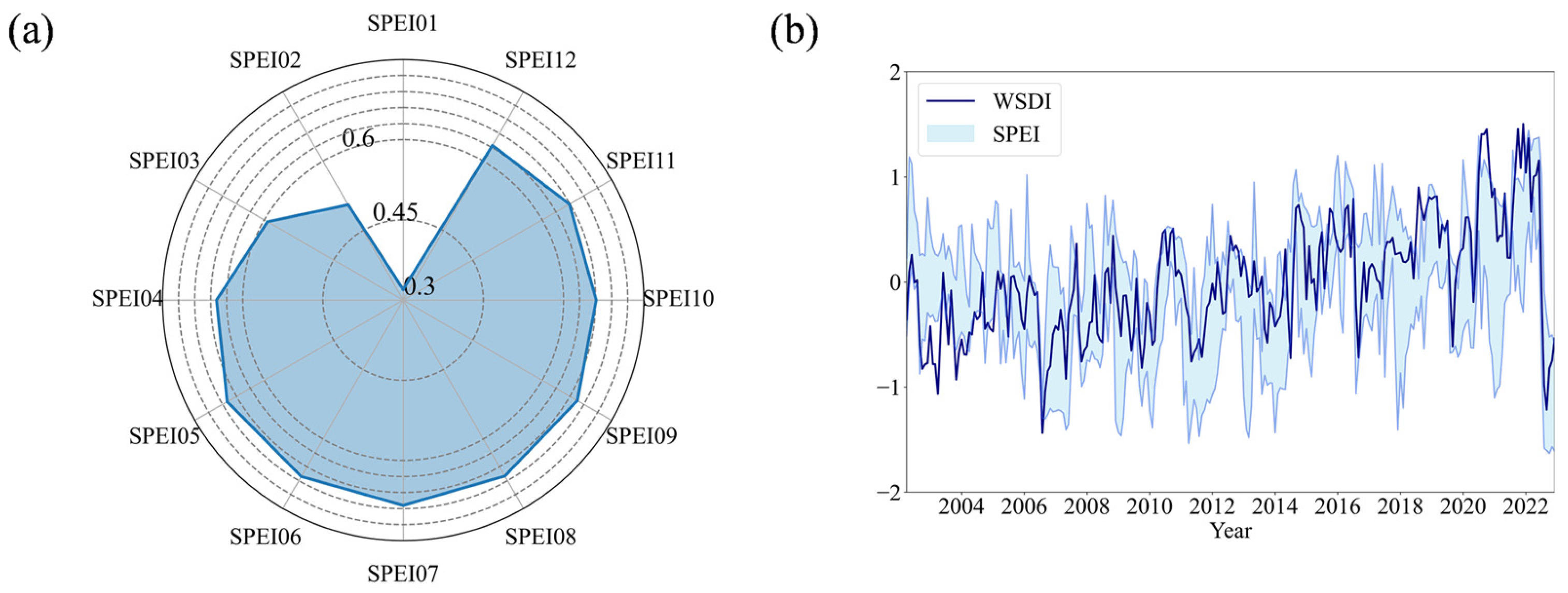
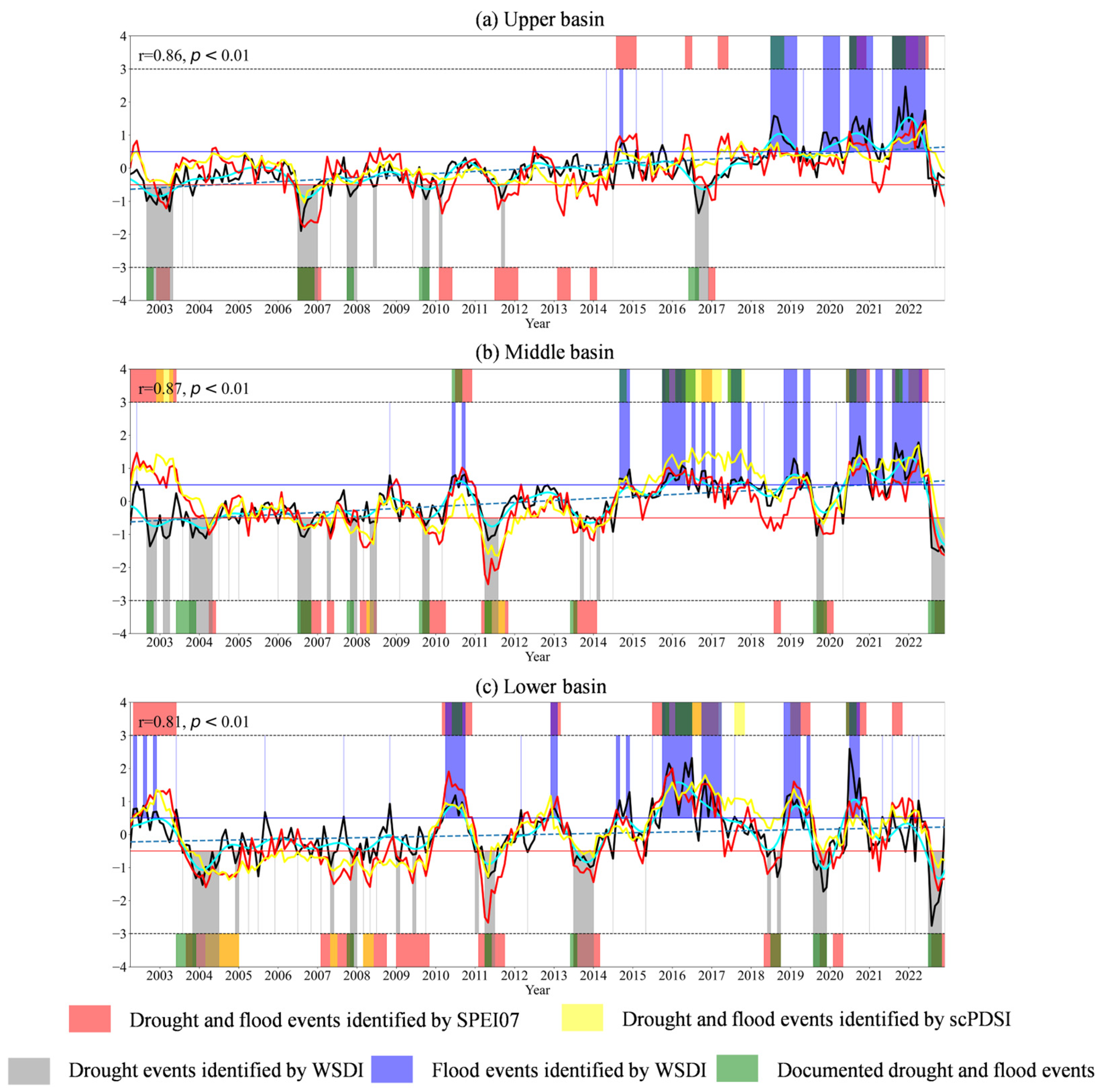
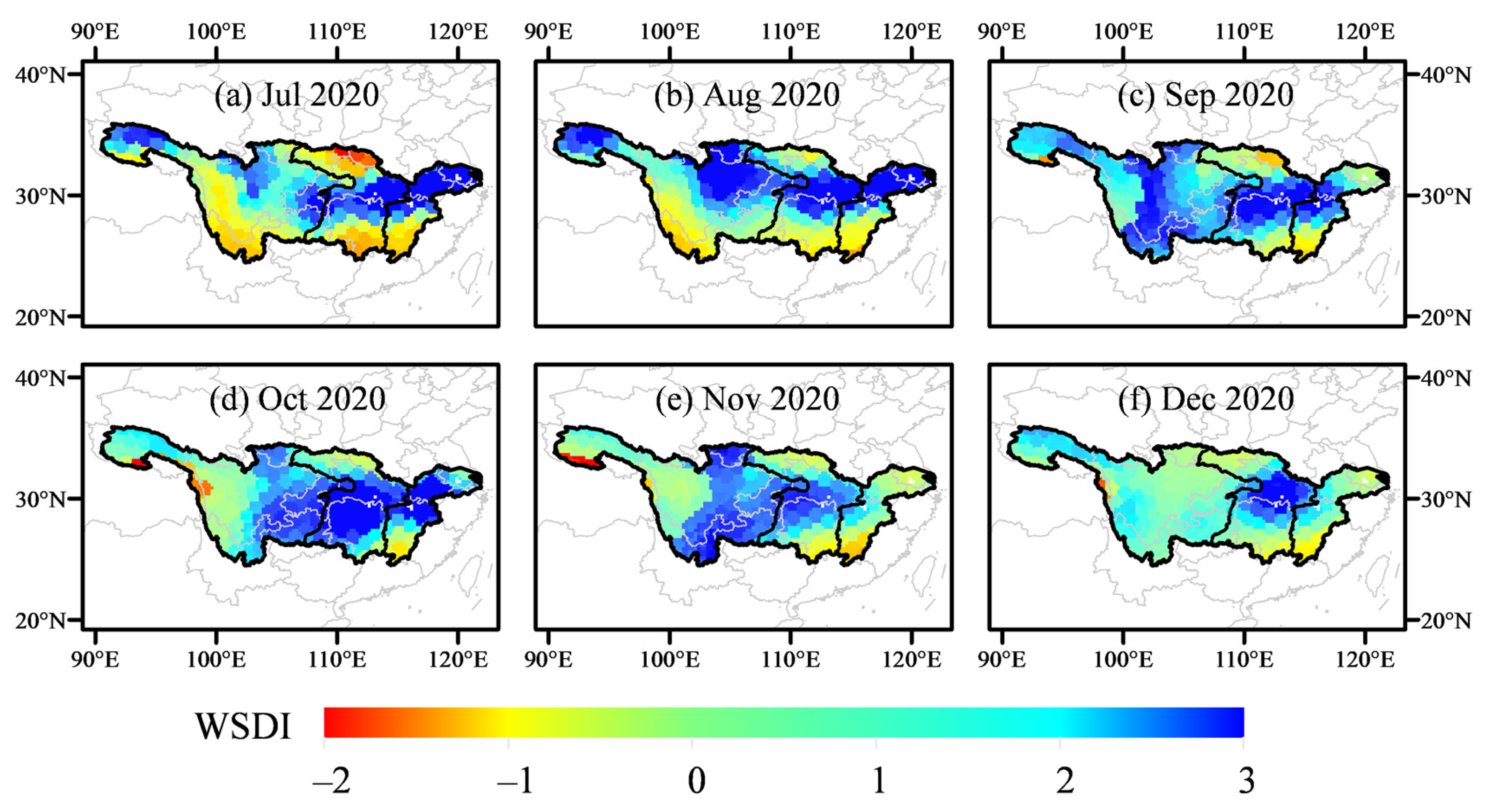

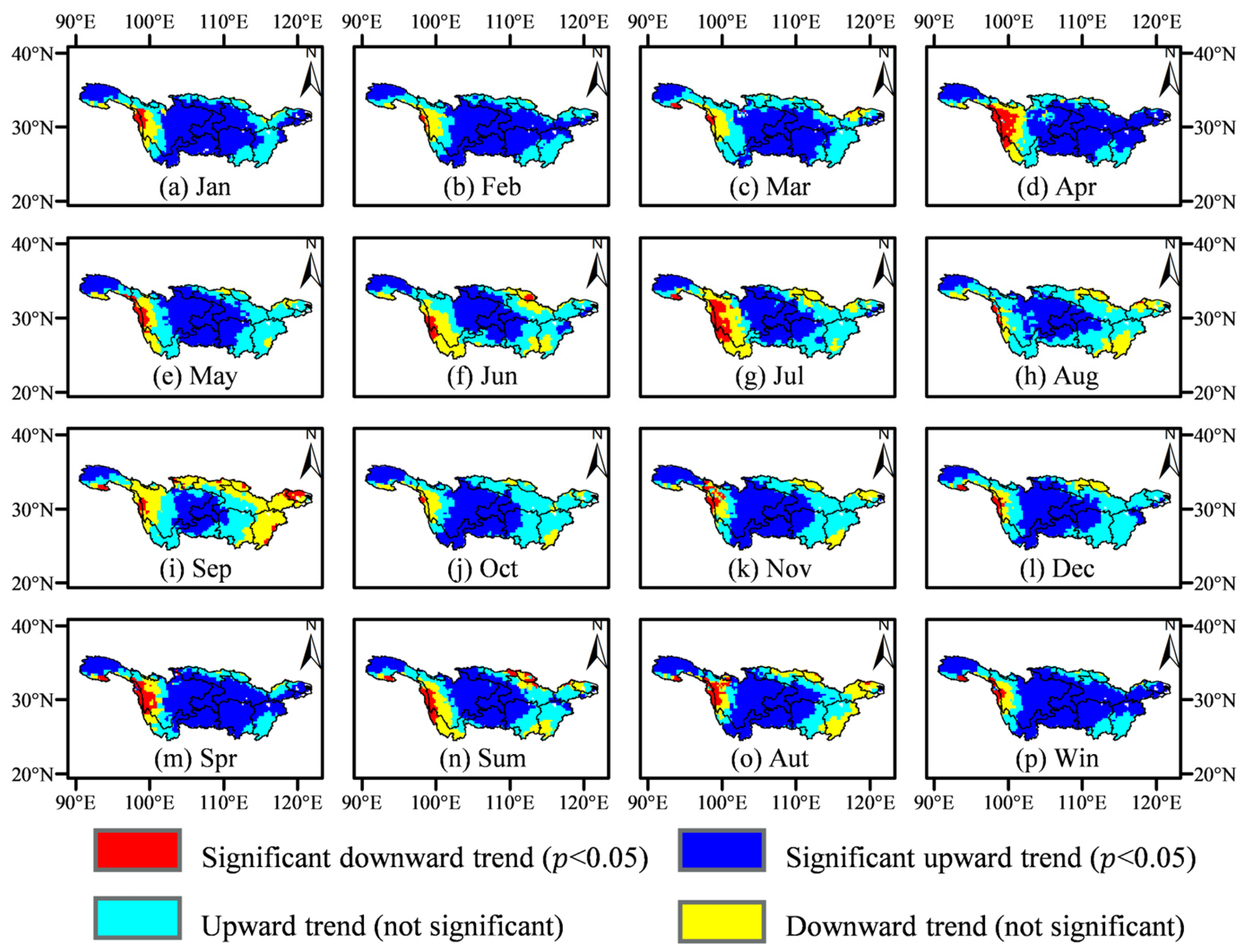

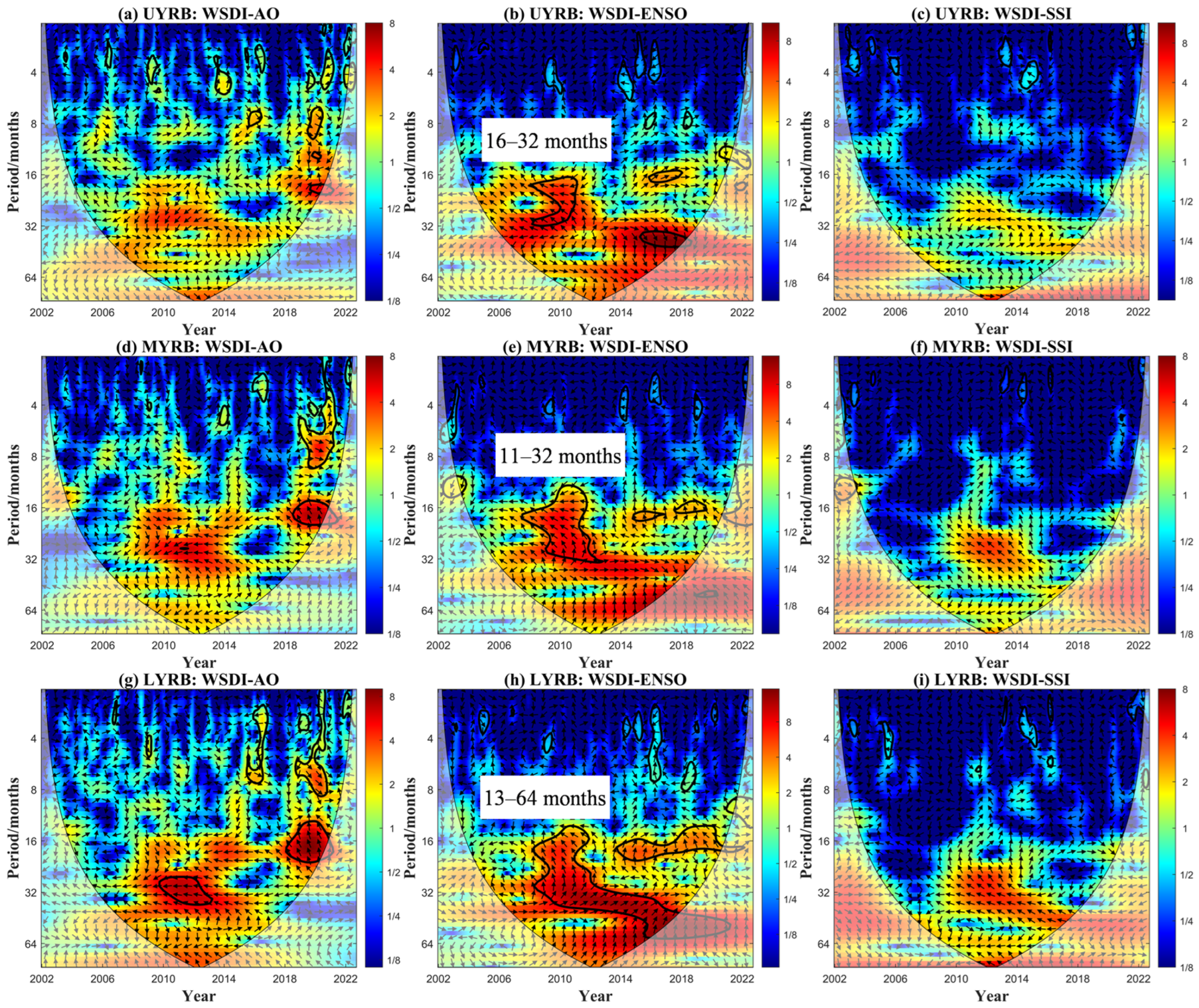
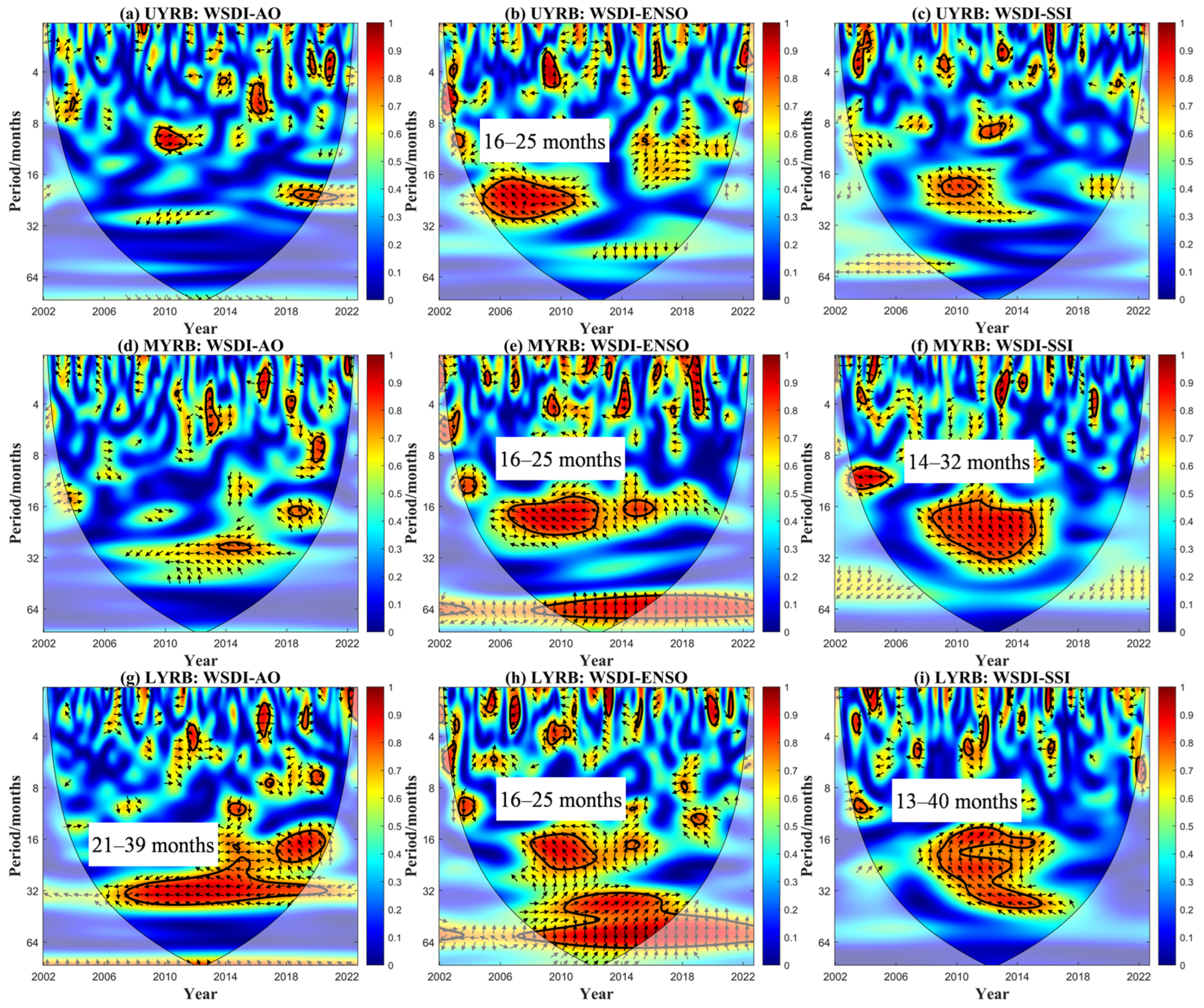
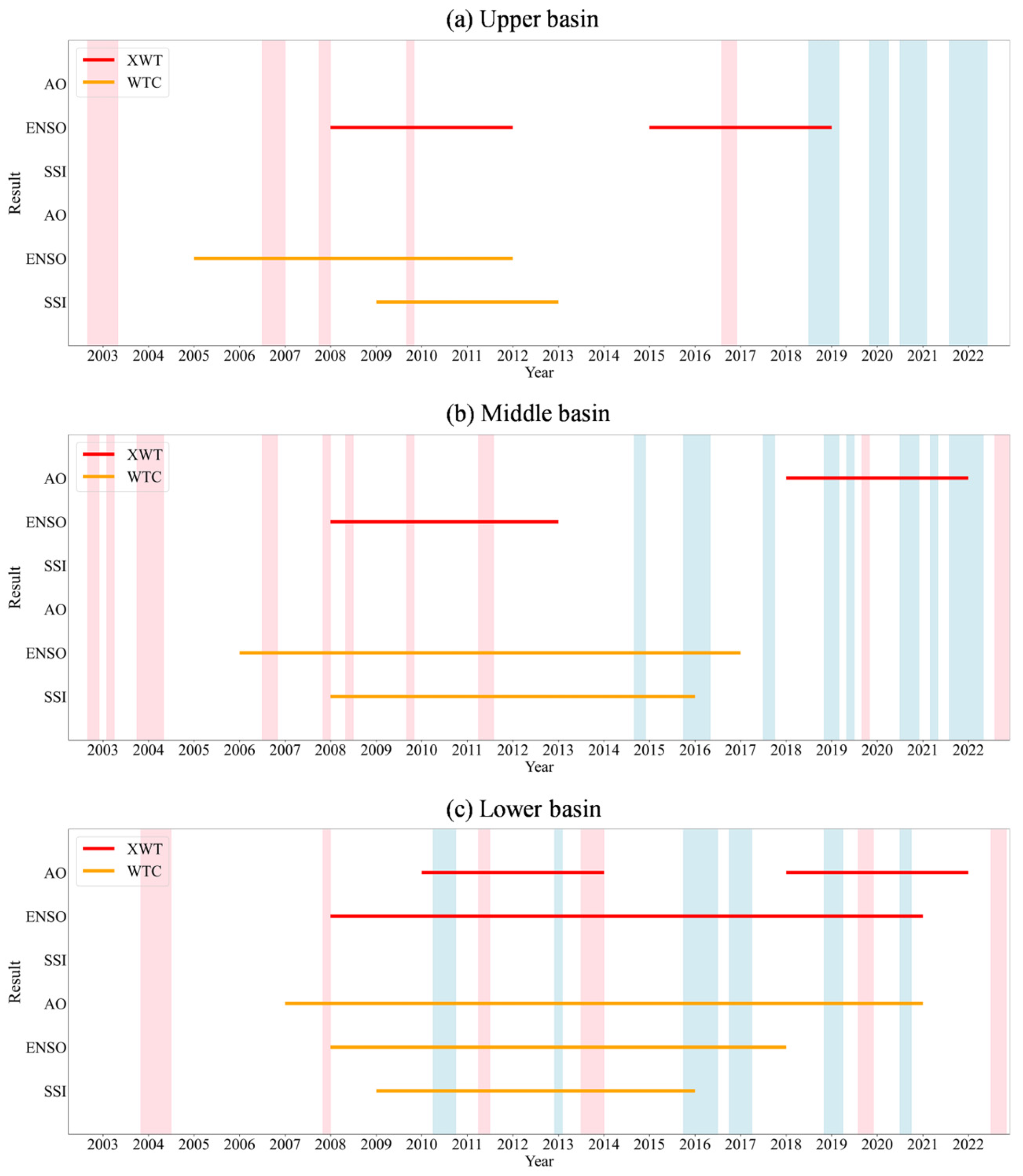
| Variable | Product | Resolution | Period | Source |
|---|---|---|---|---|
| TWSA | GRACE/GFO RL06 Mascon | 0.25°, monthly | 2002–2022 | https://www2.csr.utexas.edu/grace (accessed on 21 April 2024) |
| GLDAS NOAH | 0.25°, monthly | 2002–2022 | https://disc.gsfc.nasa.gov/datasets/ (accessed on 22 April 2024) | |
| WGHM v2.2d | 0.5°, monthly | 2002–2019 | https://doi.org/10.1594/PANGAEA.918447 (accessed on 22 April 2024) | |
| Precipitation | ERA5-L | 0.1°, monthly | 2002–2022 | https://doi.org/10.24381/cds.e2161bac (accessed on 28 April 2024) |
| Temperature | ERA5-L | 0.1°, monthly | 2002–2022 | https://doi.org/10.24381/cds.e2161bac (accessed on 18 April 2025) |
| scPDSI | Preliminary 4.07 | 0.5°, monthly | 2002–2022 | https://crudata.uea.ac.uk/cru/data/drought/ (accessed on 22 April 2025) |
| SPEI01-12 | SPEIbase v2.9 | 0.5°, monthly | 2002–2022 | https://digital.csic.es/handle/10261/332007 (accessed on 28 April 2024) |
| Documented events | CWRC Bulletin | -, yearly | 2002–2022 | http://www.cjw.gov.cn/zwzc/zdgk/jyys/szygb/ (accessed on 17 May 2024) |
| Teleconnection factors | AO | -, monthly | 2002–2022 | https://www.cpc.ncep.noaa.gov/ (accessed on 3 June 2024) |
| ENSO | -, monthly | 2002–2022 | https://psl.noaa.gov/enso/mei/ (accessed on 3 June 2024) | |
| SSI | -, monthly | 2002–2022 | https://www.sidc.be/SILSO/datafiles (accessed on 3 June 2024) |
| Category | WSDI/SPEI | scPDSI |
|---|---|---|
| Extreme flood | ≥2 | ≥4 |
| Severe flood | [1.5, 2) | [3, 4) |
| Moderate flood | [1, 1.5) | [2, 3) |
| Mild flood | [0.5, 1) | [1, 2) |
| Normal | (−0.5, 0.5) | (−1, 1) |
| Mild drought | (−1, −0.5] | (−2, −1] |
| Moderate drought | (−1.5, −1] | (−3, −2] |
| Severe drought | (−2, −1.5] | (−4, −3] |
| Extreme drought | ≤−2 | ≤−4 |
| Regions | Types | Period | Duration (Month) | Peak Value (Peak Date) |
|---|---|---|---|---|
| UYRB | Drought | 2002.09–2003.05 | 9 | −1.30 (2003.04) |
| 2006.07–2007.01 | 7 | −1.90 (2006.08) | ||
| 2007.10–2008.01 | 4 | 0.85 (2007.11) | ||
| 2009.09–2009.11 | 3 | 0.94 (2009.10) | ||
| 2016.08–2016.12 | 5 | −1.36 (2016.09) | ||
| Flood | 2018.07–2019.03 | 9 | 1.58 (2018.08) | |
| 2019.11–2020.04 | 7 | 1.08 (2019.12) | ||
| 2020.07–2021.02 | 8 | 1.56 (2020.09) | ||
| 2021.08–2022.06 | 11 | 2.47 (2021.12) | ||
| MYRB | Drought | 2002.09–2002.12 | 4 | −1.36 (2002.10) |
| 2003.02–2003.04 | 3 | −1.12 (2003.03) | ||
| 2003.10–2004.05 | 8 | −1.12 (2004.03) | ||
| 2006.07–2006.11 | 5 | −1.08 (2006.09) | ||
| 2007.11–2008.01 | 3 | −0.69 (2007.11) | ||
| 2008.05–2008.07 | 3 | −0.66 (2008.05) | ||
| 2009.09–2009.11 | 3 | −0.73 (2009.10) | ||
| 2011.04–2011.08 | 5 | −1.18 (2011.05) | ||
| 2019.09–2019.11 | 3 | −1.04 (2019.09) | ||
| 2022.08–2022.12 | 5 | −1.53 (2022.12) | ||
| Flood | 2014.10–2014.12 | 3 | 0.96 (2014.12) | |
| 2015.10–2016.05 | 8 | 1.08 (2016.04) | ||
| 2017.07–2017.10 | 4 | 0.73 (2017.10) | ||
| 2018.11–2019.03 | 5 | 1.30 (2019.02) | ||
| 2019.05–2019.07 | 3 | 0.87 (2019.06) | ||
| 2020.07–2020.12 | 6 | 1.97 (2020.10) | ||
| 2021.03–2021.05 | 3 | 1.28 (2021.04) | ||
| 2021.08–2022.05 | 10 | 1.78 (2022.04) | ||
| LYRB | Drought | 2003.11–2004.07 | 9 | −1.53 (2004.02) |
| 2007.11–2008.01 | 3 | −0.74 (2007.12) | ||
| 2011.04–2011.07 | 4 | −1.31 (2011.05) | ||
| 2013.07–2014.01 | 7 | −0.99 (2013.12) | ||
| 2019.08–2019.12 | 5 | −1.73 (2019.11) | ||
| 2022.07–2022.11 | 5 | −2.77 (2022.08) | ||
| Flood | 2010.04–2010.10 | 7 | 1.19 (2010.07) | |
| 2012.12–2013.02 | 3 | 0.82 (2013.01) | ||
| 2015.10–2016.07 | 10 | 2.31 (2016.07) | ||
| 2016.10–2017.04 | 7 | 1.64 (2016.11) | ||
| 2018.11–2019.04 | 6 | 1.22 (2019.01) | ||
| 2020.07–2020.10 | 4 | 2.59 (2020.07) |
Disclaimer/Publisher’s Note: The statements, opinions and data contained in all publications are solely those of the individual author(s) and contributor(s) and not of MDPI and/or the editor(s). MDPI and/or the editor(s) disclaim responsibility for any injury to people or property resulting from any ideas, methods, instructions or products referred to in the content. |
© 2025 by the authors. Licensee MDPI, Basel, Switzerland. This article is an open access article distributed under the terms and conditions of the Creative Commons Attribution (CC BY) license (https://creativecommons.org/licenses/by/4.0/).
Share and Cite
Ren, R.; Nemoto, T.; Raghavan, V.; Song, X.; Duan, Z. Analysis of Droughts and Floods Evolution and Teleconnection Factors in the Yangtze River Basin Based on GRACE/GFO. Remote Sens. 2025, 17, 2344. https://doi.org/10.3390/rs17142344
Ren R, Nemoto T, Raghavan V, Song X, Duan Z. Analysis of Droughts and Floods Evolution and Teleconnection Factors in the Yangtze River Basin Based on GRACE/GFO. Remote Sensing. 2025; 17(14):2344. https://doi.org/10.3390/rs17142344
Chicago/Turabian StyleRen, Ruqing, Tatsuya Nemoto, Venkatesh Raghavan, Xianfeng Song, and Zheng Duan. 2025. "Analysis of Droughts and Floods Evolution and Teleconnection Factors in the Yangtze River Basin Based on GRACE/GFO" Remote Sensing 17, no. 14: 2344. https://doi.org/10.3390/rs17142344
APA StyleRen, R., Nemoto, T., Raghavan, V., Song, X., & Duan, Z. (2025). Analysis of Droughts and Floods Evolution and Teleconnection Factors in the Yangtze River Basin Based on GRACE/GFO. Remote Sensing, 17(14), 2344. https://doi.org/10.3390/rs17142344







